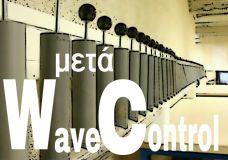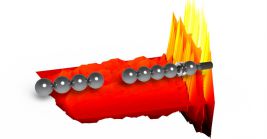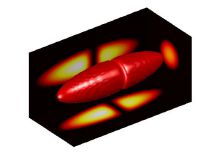
We are studying the control of wave propagation utilizing acoustic metamaterial structures. The approach we are following and the resulting phenomenology are not restricted to acoustics, and thus, our findings could find applications to all the domains of wave physics, from matter to electromagnetic and optical waves
In particular, our interests include:
Slow Sound, Coherent Perfect Absorption, Acoustic Solitons,
Locally Symmetric Acoustic Structures.
Acoustic metamaterials for the control of sound propagation:
The phenomenon of Bose-Einstein condensation is a quantum phase transition originally predicted by Bose and Einstein in 1924. In particular, it was shown that below a critical transition temperature, Tc, a finite fraction of particles of a boson gas (i.e., whose particles obey the Bose statistics) condenses into the same quantum state, known as the Bose-Einstein condensates (BEC). The first BECs were realized experimentally in 1995 in ultra cold atomic gases. Since then, BECs have been the focus of intense research. The significance and importance of the emergence of atomic BECs has been recognized through the 2001 Nobel Prize in Physics.
From a theoretical standpoint, and for experimentally relevant conditions, the static and dynamical properties of a BEC can be described by means of an effective mean-field equation known as the Gross-Pitaevskii (GP) equation.Over the last several years of my PhD and post-doctoral research, I investigated the emergence, stability, bifurcation, dynamics and interactions of nonlinear collective excitations in atomic BECs using the GP equation. The outcomes can be coarsely grouped as follows:
1.Generation, dynamics and interactions of dark solitons in atomic condensates:
Dark solitons have been observed in a plethora of physical systems including atomic BECs. A significant part of my dissertation work focused on the dynamics of dark solitons. I started by developing analytical methods (based on the soliton perturbation theory and the Lagrangian approach) to derive effective particle models. These models describe in a clear physical way the dynamics of dark solitons in a 1D, harmonically trapped BEC. To verify the validity of the analytical predictions, I compared them with direct numerical simulations of the GP equation. In following works, I also studied their manipulation by means of periodic potentials and proposed an experimentally tractable setting for their generation.
I was also involved in a European research project with the theoretical group of Prof. Peter Schmelcher and the experimental group of Prof. Markus Oberthaler. Within this project, I spent the summer of 2004 and the November of 2005 in the University of Heidelberg continuing my research on dark solitons. The collaboration with these groups gave me crucial insight into the experiments, and allowed me to realize the importance of various physical features, such as the so-called dimensionality crossover in low-dimension BECs. This led me to the study of the statics and dynamics of dark solitons in this dynamical regime. The main result of this work was the prediction of a substantial deviation (of the order of 10% or more) from the soliton oscillation frequency in the purely 1D regime. Experimental results from a joint work with Prof. Markus Oberthaler’s group, confirmed this prediction. We also reported for the first time subsequent oscillations and interactions of dark solitons. In subsequent work, we studied in more detail the dark soliton interactions as well as the stability of multiple dark solitons in cigar-shaped geometries.
2. Bifurcations and spectral stability of nonlinear excitations in atomic condensates:
Over the years of my graduate studies, I also became interested in bifurcation theory. In joint work with Pr. Panos Kevrekidis, I studied mathematical and computational methods of applied dynamical systems. Specifically, I developed a few-modes Galerkin projection approach, fixed-point algorithms (Newton-Raphson type), spectral stability analysis, and parametric continuation. We successfully applied these tools for atomic condensates trapped in various external potentials (harmonic traps, double wells, optical lattices), predicting various types of bifurcations.
3. Pattern forming dynamical instabilities and novel coherent structures:
Here, I focused on pattern-forming dynamical instabilities of BECs in both 1D and 2D settings, including the modulational instability in 1D attractive BECs and the transverse instability of dark solitons in 2D repulsive BECs. These instabilities are typical examples of long-wavelength perturbations that can destabilize the condensates and form patterns of coherent structures. Trains of solitons in 1D and vortex pairs forming “necklaces” in 2D are prototypical examples of the resulting nonlinear waveforms. Moreover, we suggested two mechanisms to avoid such instabilities in condensates: the first is based on engineering the trapping conditions of the condensate 25 and the second is based on changing the shape of the waveform. The latter also introduces the concept of ring dark solitons in atomic condensates.
During my graduate research, we also suggested a method that enables the generation of stable macroscopic excitations and their kinematic manipulation. This method, which we called Feshbach resonance management, is based on the controlled change of the atomic interactions of the condensates by applying temporally or spatially dependent external fields.
Granular materials are collections of macroscopic grains that interact via dissipative and nonlinear forces. These materials are of substantial importance in many industrial and natural processes while at the same time they offer a perfect test bed for new insights into problems in condensed-matter physics and materials science. Despite their seeming simplicity, granular matter behaves quite differently from the other familiar forms of matter and their rich and complex dynamic behaviour still present a major challenge in physics.
The last years, several insights have been obtained by applying statistical mechanics to study granular media. Nowadays, it is clear that nonlinear effects play a crucial role. This proposal, which resides at the interface of nonlinear dynamics, acoustics, and condensed matter physics, seeks to extend the state-of-the-art techniques, introducing tools and concepts from nonlinear and chaotic dynamics. The main objectives are: (1) a better understanding of the physics of driven granular media, (2) the design of granular-based acoustic devices for the control of acoustic propagation. A synergistic approach that combines experimental, theoretical and numerical studies is proposed. The methodology that will be followed has a strong multidisciplinary character including tools from the field of applied dynamical and chaotic systems, concepts from thermal and condensed matter physics, and experimental methods and techniques from the acoustics of granular media.


Nonlinear excitations in atomic Bose-Einstein condensates:
Georgios Theocharis
CNRS Scientist

About - Contact
Conditions - Copyright 2009
 Numento ! The collection software •
Numento ! The collection software •